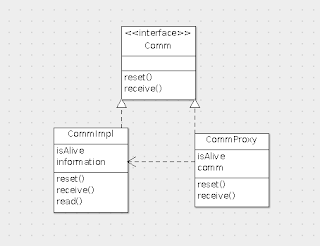This is a list of design patterns, implemented in Dojo JS
I'v found difficult to work with some restrictions as the use of static variables, in this kind of implementation
Observer
//Observer pattern
dojo.declare("com.dev.dojo.Observer",[],
{
state: "observer",
obs: null,
constructor:function(obl){
this.obs = obl;
},
update: function(sta){
this.state = sta;
status = this.obs.updateObserver(this);
console.log("udate observer result for "+ this + ": " + status);
}
});
dojo.declare("com.dev.dojo.Observable",[],
{
state: "observable",
observers: [],
Observervable:function(obss){
this.observers = obss;
},
addObserver: function(o){
idx = dojo.indexOf(this.observers,o);
if(idx!=null && idx>=0)
this.observers[idx] = o;
else
this.observers.push(o);
},
getObservers: function(){
return this.observers;
},
notifyAll: function(stat){
this.state = stat;
for(i=0;i< this.observers.length;i++)
this.observers[i].update(this.state);
},
updateObserver:function(observer){
idx = dojo.indexOf(this.observers,observer);
if(idx!=null && idx>=0){
this.observers[idx] = observer;
return 1;
}
return -1;
}
,
displayObservers: function(s) {
for(i=0;i
Singleton
//Singleton pattern
var created = false;
dojo.declare("com.dev.dojo.Singleton",[],{
singleton:null,
__isCreated__: created,
getInstance: function(){
if(!this.__isCreated__){
created = true;
this.singleton = new com.dev.dojo.Singleton();
}
return this.singleton;
},
doTask: function(seconds){
for(i=0;i
Factory Method
//Factory method pattern
dojo.declare("com.dev.dojo.Animal",[],{
type:"Animal",
saySomething: function(){
return "I'm too generic to say something";
}
});
dojo.declare("com.dev.dojo.Dog",[com.dev.dojo.Animal],{
type:"Dog",
saySomething: function(){
return "Guau,guau,guau";
}
});
dojo.declare("com.dev.dojo.Tiger",[com.dev.dojo.Animal],{
type:"Tiger",
saySomething: function(){
return "Roarrrr,roarrrrrr";
}
});
dojo.declare("com.dev.dojo.Factory",[],{
getInstance:function(type){
var instance = null;
if(type==new com.dev.dojo.Animal().type)
instance = new com.dev.dojo.Animal();
else if(type==new com.dev.dojo.Tiger().type)
instance = new com.dev.dojo.Tiger();
else if(type==new com.dev.dojo.Dog().type)
instance = new com.dev.dojo.Dog();
return instance;
}
});
var t = "Dog";
var o = com.dev.dojo.Factory().getInstance(t);
alert(o.saySomething());
t="Tiger";
o = com.dev.dojo.Factory().getInstance(t);
alert(o.saySomething());
//End of factory method
Adapter
//Adapter pattern
/* Example of adapter pattern*/
function FlyingEngine() {
var operation = "Principal ";
var state = -1;
this.turnOnEngine=function(){
this.operation += "Engine is turning ON\n";
this.state = 0;
}
this.takingOver=function(){
if(this.state<1)
this.operation += "Can't take over until engine is turn on";
this.operation += "Taking over\n";
this.state=2;
}
this.flying=function(){
if(state<2)
operation+="Not posible to fly until taking over";
this.operation += "FLYING\n";
this.state=3;
}
}
function Helicopter(){
var operation = "Principal ";
var flyingEngine = new FlyingEngine();
this.rotorsWarm=function(){
if(this.state==0){
/*adapter->*/ flyingEngine.operation = "Rotors ";
flyingEngine.turnOnEngine();
this.operation += flyingEngine.operation;
this.operation += "warming rotors:"
for(i=0;i<5;i++)
this.operation +=i
}
this.operation += "\n";
this.state+=1;
}
}
dojo.extend(Helicopter,new FlyingEngine());
var h1 = new Helicopter();
var s = "";
h1.turnOnEngine();
h1.rotorsWarm();
h1.takingOver();
h1.flying();
s = h1.operation;
alert(s);
![[ Puerto Cero Uno ]](https://blogger.googleusercontent.com/img/b/R29vZ2xl/AVvXsEhiXs7hWiiK0_ETMqSqjEYdPtKVGAtAw_S16cM3u-3t1kwYIw-FM1aSQeOkrlr9lmqom-9Kw9kz0ZoPNXfpYGC_CIbLwn20L7Ps3leRsUpjPp63xioaYTeMLJsI-2JnRc8mWwH76Jbhn-jx/s752/puertocerounobanner.jpg)
